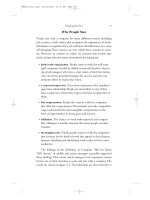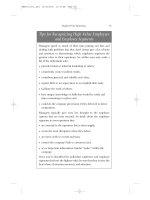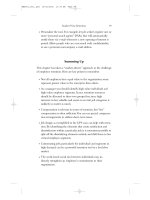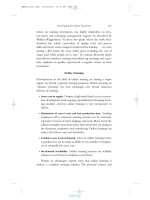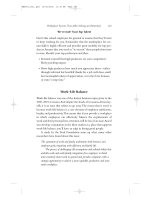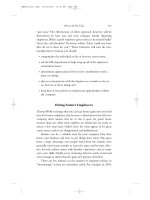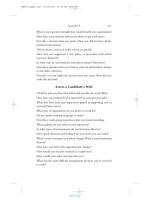Tài liệu Hiring and Keeping the Best People 22 pdf
Bạn đang xem bản rút gọn của tài liệu. Xem và tải ngay bản đầy đủ của tài liệu tại đây (125.81 KB, 8 trang )
Notes
Introduction
1. For the cost of “mis-hires,” see Bradford D. Smith, Topgrading (New
York: Prentice Hall Press, 1999), 45–59.
Chapter 1
1. Based on “21st-Century Job Descriptions,” Harvard Management
Communication Letter (February 2001): 10–11.
2. Pierre Mornell, Hiring Smart! (Berkeley, CA:Ten Speed Press,1998),
123.
3. Ibid., 124
Chapter 2
1. This section draws heavily on “Online Hiring? Do It Right,” Har-
vard Management Update, February 2000.
2. Peter Cappelli,“Making the Most of On-Line Recruiting,” Harvard
Business Review 79, no. 3 (March 2001): 139–146.
3. Claudio Fernández-Araóz, “Hiring Without Firing,” Harvard Busi-
ness Review 77, no. 4 (July–August 1999): 108–120.
4. Ibid.,114.
5. Ibid., 114–115.
6. See Melissa Raffoni,“Use Case Interviewing to Improve Your Hir-
ing,” Harvard Management Update, July 1999.
7. Ibid.
8. Timothy Butler and James Waldroop, “Job Sculpting: The Art of
Retaining Your Best People,” Harvard Business Review 77, no. 5 (Septem-
ber–October 1999): 144–152.
9. Ibid., 144–152.
10. Subrata Chakravarty, “A Model of Superb Management: Hit ’Em
Hardest with the Mostest,” Forbes, 16 September 1991: 48-51.
155
HBE001_Notes_.qxd 10/02/2002 11:47 AM Page 155
156 Notes
11. As told in Dwight Gertz and João P.A. Baptista, Grow to Be Great
(New York:The Free Press, 1995), 154–155.
12. Material in this section is drawn from Edward Prewitt,“Personality
Tests in Hiring: How to Do It Right,” Harvard Management Update, Octo-
ber 1998.
13. All quotes from Tom Norton are cited in Prewitt.
14. Ibid.
Chapter 3
1. “Commitment in the Workplace: The 1999 Employee Relation-
ship Report Benchmark Study,” Hudson Institute/Walker Information.
2. Anthony J. Rucci, Steven P. Kirn, and Richard T. Quinn, “The
Employee-Customer-Profit Chain at Sears,” Harvard Business Review 76,
no. 1 ( January–February 1998): 83–97.
3. Dave Ulrich, Richard Halbrook, Dave Meder, Mark Stuchlik, and
Steve Thorpe,“Employee and Customer Attachment: Synergies for Com-
petitive Advantage,” Human Resource Planning 14, no. 2 (June 1991):
89–103.
4. “Attraction and Retention from Employee Perspectives,” William
M. Mercer, Internal Report,April 1998.
5. “How to Keep Your 50-Somethings,” Harvard Management Update,
September 1999.
6. Kristen B. Donahue, “Why Women Leave—And What Corpora-
tions Can Do About It,” Harvard Management Update, June 1998.
7. Ed Michaels, Helen Handfield-Jones, and Beth Axelrod, The War for
Talent (Boston, MA: Harvard Business School Press, 2001), 47.
8. Charles Fishman,“Sanity, Inc.,” Fast Company, January 1999, 87.
Chapter 4
1. Peter Cappelli, “A Market-Driven Approach to Retaining Talent,”
Harvard Business Review 78, no. 1 ( January–February 2000): 103–111.
2. The application of customer retention concepts to the problem of
employee retention has been articulated in an unpublished work by
Robert Duboff, Hobson’s Solution: Putting People and Customers First, Ernst
& Young, LLP, 2001. In it, Duboff advises companies to begin looking at
their employees as customers. Doing so, he believes, makes it possible to
apply proven marketing concepts to the task of identifying and retaining
the most valuable employees and employee segments.
3. Ibid., 107.
4. See Frederick Herzberg,“One More Time: How Do You Motivate
Employees?” Harvard Business Review 65, no. 5 (September–October 1987):
109–120.
HBE001_Notes_.qxd 10/02/2002 11:47 AM Page 156
5. American Management Association/Ernst & Young Survey press
release, Ernst & Young, LLP, 20 April 1999.
6. Cappelli, “A Market-Driven Approach to Retaining Talent,” 105-
106.
7. Timothy Butler and James Waldroop, “Job Sculpting: The Art of
Retaining Your Best People,” Harvard Business Review 77, no. 5 (Septem-
ber–October 1999): 144–152.
8. Cappelli,“A Market-Driven Approach to Retaining Talent,” 108.
9. Ibid., 109.
Chapter 5
1. The Gallup Organization, Employees Speak Out on Job Training: Find-
ings of a New Nationwide Study, 1999.
2. U.S. Bureau of Labor Statistics, “BLS Reports on Employer-
Provided Formal Training,” press release, 23 September 1994.
3. Clair Brown and Michael Reich, “Developing Skills through
Career Ladders: Lessons from Japanese and U.S. Companies, California
Management Review 39, no. 2 (Winter 1997): 124–125.
4. Ibid., 129.
5. “Corporate Universities: The New Pioneers of Management Edu-
cation: An Interview with Jeanne Meister,” Harvard Management Update,
October 1999.
6. See Edward E. Gordon,“Investing in Human Capital:The Case for
Measuring Training ROI,” Corporate University Review, January-February
1997.
7. William Wiggenhorn, “Motorola U: When Training Becomes an
Education,” Harvard Business Review 68, no. 4 (July–August 1990): 75.
8. Linda A. Hill, Becoming a Manager (Boston, MA: Harvard Business
School Press, 1992), 218.
9. Beth Axelrod, Helen Handfield-Jones, and Ed Michaels, “A New
Game Plan for C Players,” Harvard Business Review 80, no. 1 (January 2002):
83.
10. Ibid., 85.
11. Hank Gilman and Lori Ioannou, “The Smart Way to Hire Super-
stars,” Fortune, 10 July 2000, online edition, <www.fortune.com>.
Chapter 6
1. Rhona Rapaport and Lotte Bailyn, “Rethinking Life and Work,”
The Ford Foundation, <www.fordfound.org>.
2. Juliet Schor, The Overworked American (New York: Basic Books,
1998), 12.
Notes 157
HBE001_Notes_.qxd 10/02/2002 11:47 AM Page 157
TEAMFLY
Team-Fly
®
3. Stewart D. Friedman, Perry Christensen, and Jessica DeGroot,
“Work and Life: The End of the Zero Sum Game,” Harvard Business Review
76, no. 6 (November–December 1998): 119–129.
4. Ibid., 121.
5. Ibid., 122.
6. Ibid., 124.
7. See the ITAC web site at <> for its
definition of telework and its most recent research findings.
8. See < for AT&T’s most recent re-
search on telework. The site also includes many articles on this subject as
well as a “getting started” guide to implementing telework programs and
policies.
9. Mahlon Apgar IV, “The Alternative Workplace: Changing Where
and How People Work,” Harvard Business Review 76, no. 3 (May–June,
1998): 121–136.
10. See < />11. Felice N. Schwartz, “Management Women and the New Facts of
Life,” Harvard Business Review 67, no. 1 ( January–February, 1989): 65–76.
Chapter 7
1. See BCG’s Web site, < />login.asp>, 22 February 2002.
2. “Alumni Relations During a Downturn,” Daily Deal, 27 September
2001.
158 Notes
HBE001_Notes_.qxd 10/02/2002 11:47 AM Page 158
Glossary
AFFILIATION
The opportunity to work with liked, admired, and
respected colleagues; a work value that many employees consider
important.
ALUMNI RELATIONS
An organized program that aims to maintain posi-
tive links between the firm and former employees.
ATTRITION
The departure of employees.
BOOMERANG
A former employee who is rehired.
BURNOUT
Work exhaustion resulting from overload or other changes in
an employee’s work situation.
CONTINGENT WORK FORCE
The portion of the work force consisting of
part-time employees, freelancers, and temporary workers.
DEMOGRAPHIC CHANGE
Change in the makeup of a population (for
example, age, gender, or racial proportions).
DIVERSITY
Variation in age, gender, race, ethnicity, sexual orientation,
physical ability, and other characteristics in the work force.
FREE AGENCY
Self-employment, in which workers serve various clients
on a temporary, contractual basis.
GEN-XERS
Twenty- to thirty-year-old employees; a term used most
commonly in the United States.
INTELLECTUAL CAPITAL
The knowledge and skills of employees that cre-
ate value for the organization.
JOB DESCRIPTION
A profile of a job, its essential functions, reporting
relationships, hours, and required credentials.
159
HBE001_Glos_.qxd 10/02/2002 11:47 AM Page 159
